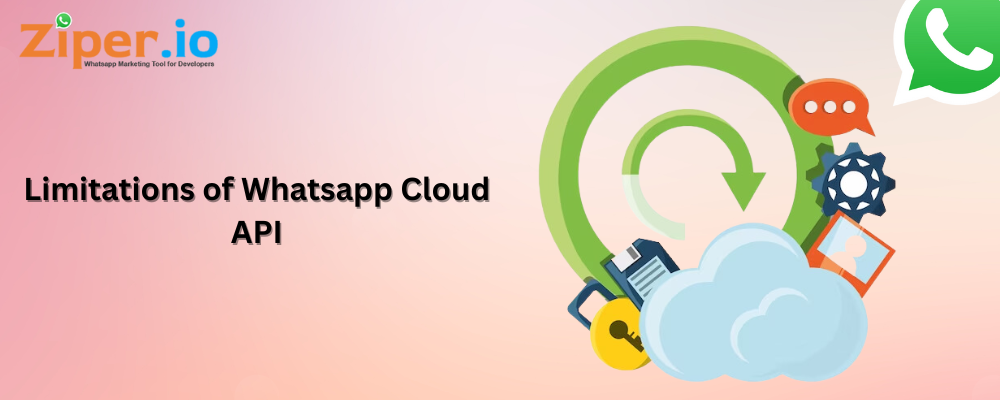Limitations of Whatsapp Cloud API

WhatsApp, the popular messaging platform, offers a Cloud API that allows developers to integrate WhatsApp functionality into their applications. While the WhatsApp Cloud API provides a range of benefits, it's essential to be aware of its limitations. In this blog post, we'll explore the key limitations of the WhatsApp Cloud API and how they can impact your development efforts.
Understanding the WhatsApp Cloud API
To comprehend the limitations of the WhatsApp Cloud API fully, it's crucial to have a solid understanding of how it works. The API allows developers to leverage WhatsApp's messaging features, such as sending and receiving messages, utilizing a cloud-based platform. However, it's important to note that the API has certain constraints that may affect its usability.
Limitation 1: Lack of Multimedia File Support
One of the key limitations of the WhatsApp Cloud API is the lack of support for multimedia file types. While the API enables sending text-based messages, it doesn't provide the capability to send images, videos, or audio files directly. This limitation can restrict the functionality of applications that heavily rely on multimedia content.
Limitation 2: Limited Message Template Options
Another constraint of the WhatsApp Cloud API is the limited availability of message templates. Message templates are pre-approved message formats that can be sent to users without any additional approval. However, the API imposes restrictions on the number and types of message templates that can be used. This limitation can hinder the flexibility and personalization options for your application's messaging experience.
Limitation 3: Restricted Access to User Data
To protect user privacy, the WhatsApp Cloud API provides limited access to user data. While you can send and receive messages, access to user profile information, such as profile pictures and status updates, is restricted. This limitation ensures that user data remains secure but may limit the extent to which your application can leverage user information.
Limitation 4: No Support for Group Management
Unfortunately, the WhatsApp Cloud API does not support group management functionalities. This means that you cannot create, modify, or manage WhatsApp groups programmatically using the API. If your application relies on group interactions, this limitation can restrict the scope of your application's capabilities.
Limitation 5: Limited Automation Capabilities
While the WhatsApp Cloud API allows for automated messaging, there are limitations to the extent of automation possible. The API does not support features such as scheduled messaging, auto-responders, or chatbot-like interactions. This limitation can impact applications that require advanced automation and real-time communication.
Limitation 6: Message Sending Limitations
The WhatsApp Cloud API imposes certain limitations on the number of messages that can be sent within specific timeframes. These limitations vary depending on the type of account you have and can impact the scalability and speed of your application. It's crucial to consider these limitations to ensure your application can handle the expected message volumes and avoid any disruptions in service.
Overcoming Limitations: Best Practices for Integration
While the limitations of the WhatsApp Cloud API can present challenges, there are strategies you can employ to work around them effectively. Here are some best practices for integrating the WhatsApp Cloud API into your applications:
Plan for alternative file-sharing methods: Since the WhatsApp Cloud API lacks multimedia file support, consider utilizing other services or APIs specifically designed for handling images, videos, or audio files. You can integrate these services alongside the WhatsApp Cloud API to provide a seamless multimedia experience within your application.
Maximize the use of available message templates: While there may be limitations on the number and types of message templates, make the most out of the ones available. Customize them to suit your application's needs and ensure they provide a personalized and engaging user experience.
Leverage user-provided data: Although access to user profile information is limited, make use of the available data to enhance user interactions. Utilize the data you can access to personalize messages and tailor the user experience within the boundaries set by the API.
Explore alternative solutions for group management: If your application heavily relies on group interactions, consider using other messaging platforms or APIs that provide comprehensive group management functionalities. By integrating multiple platforms, you can offer a seamless experience while still utilizing the WhatsApp Cloud API for individual messaging.
Implement additional automation tools: To overcome the limited automation capabilities of the WhatsApp Cloud API, consider integrating third-party automation tools or chatbot frameworks. These tools can provide advanced automation features, such as scheduling messages or implementing interactive chatbot interactions, complementing the functionality offered by the API.
Monitor message sending limits and adjust accordingly: Stay vigilant of the message sending limitations imposed by the API and monitor your message volumes closely. Implement mechanisms to track and manage message counts, ensuring you stay within the allowed thresholds to maintain a smooth and uninterrupted messaging experience for your users.
Conclusion
The WhatsApp Cloud API offers valuable messaging capabilities for application developers. However, it's important to be aware of its limitations to effectively plan and develop your applications. By understanding and strategizing around the limitations discussed in this blog post, you can optimize your integration with the WhatsApp Cloud API and provide a seamless messaging experience for your users while ensuring compliance with the API's constraints.